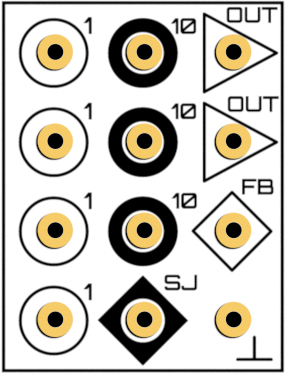Summer
A Summer is an elementary analog computing element. It carries out a summation of its inputs, as in a + b = c. Here, a and b are called the summands and c is the sum. The Analog Thing features four summers, allowing four summations in a circuit.
Elements of Each Summer on The Analog Thing
- Circles represent inputs, triangles represent outputs.
- Each of the summers of THAT has four unweighted inputs (labeled 1) and three inputs weighted with factor 10 (labeled 10).
- In the lower right corner of each of the summers, a
GROUNDsocket (0) is available. - Each of the summers has a
SJand aFBsocket. Beginners may ignore these for the time being. - Each of the summers has two output sockets.
Basic Usage of a Summer on The Analog Thing
- Put each quantity you want to sum into a different circle. Don't connect different outputs to the same input.
- You can use both output sockets as you like and stack connectors however you like.
![]() Attention: Make sure the sum of your inputs does not exceed the machine unit (±1), otherwise an overload occurs (indicated by the
Attention: Make sure the sum of your inputs does not exceed the machine unit (±1), otherwise an overload occurs (indicated by the OL LED) ![]() . See Machine Units for details.
. See Machine Units for details.
Extended Usage of a Summer
- If you choose input weight 10, you perform an amplification of this input. For details, see below.
- SJ: To extend number of inputs, connect the SJ panel of the summer with an SJ panel of a XIR element. Now the other panels of the corresponding XIR element function as inputs of the connected summer.
- FB: To convert a summer to an open amplifier, connect the FB-pannel to ground (the one directly below).
Mathematics and Electronics about analog summing
sum = - weight1 * input1 + weight2 * input2 + ...
Summation in analog computers is based on Kirchhoffs Law, which describes the conservation of current, or electrons, in particular. In a summing point (summing junction), the sum of the incoming and outgoing currents add up to zero. Summers are implemented with closed-loop operational amplifiers [1]. On THAT, you find the corresponding electronic circuits in File:Anathing_v1.0_base_3.pdf. As you can see there, summers (as well as Integrators) are implemented with ICs called TL074H. If you look for the Datasheet for the TL074H, you find for instance section 6.17 Electrical Characteristics: TL07xH on page 17.
Other summers in The Analog Thing
Inverters are electronically identical to summers. With their summing junctions, they can be used as summers if no more summers are available. See the article about Inverters and the XIR for more details. The Integrators are by definition also summing but cannot be stopped from integrating except in IC mode (see Modes).

